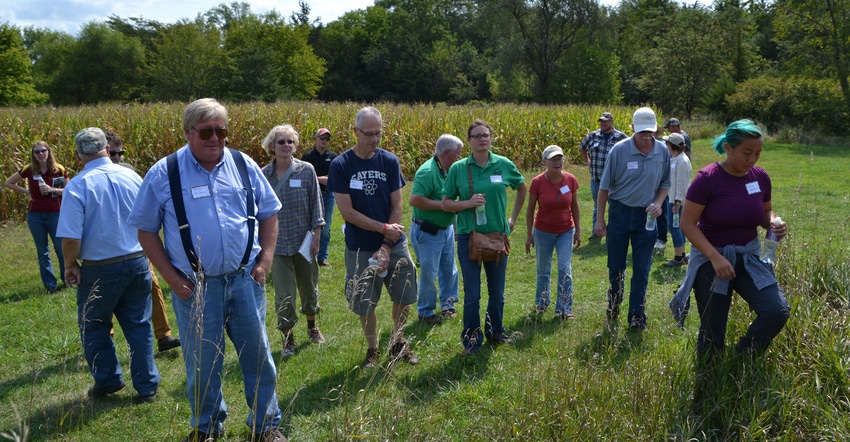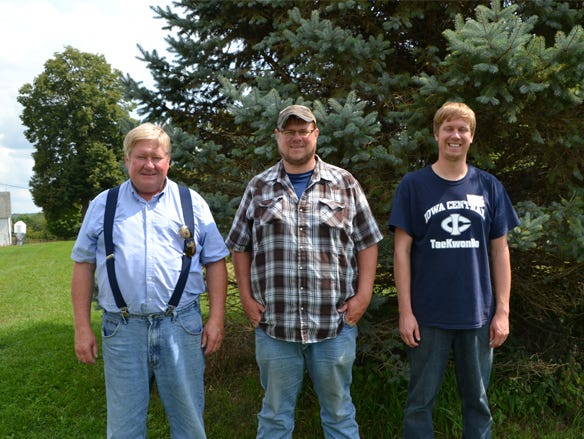October 16, 2017

Prairie potholes are usually small in size, but when farmed, these perennially wet spots on the landscape can have outsize implications for the environment and farm profitability.
The Prairie Pothole Region extends from Canada south and east, and through parts of Montana, North Dakota, South Dakota, Minnesota and Iowa. In Iowa, many potholes are found in the Des Moines Lobe, an area that spans the north-central part of the state, ending around the Polk-Story county line and the vast majority of them are farmed.
These areas in crop fields habitually yield poorly and drag field yield averages down, and they are prone to nutrient loss and leaching, raising questions about the benefits of continuing to grow corn and soybeans in them. On Aug. 31, about 25 people gathered at the farm of Jerry Peckumn, near Jefferson, to explore these questions and learn what new research from Iowa State University is revealing about these unique remnants of Iowa’s glacial past.
Researching pothole profitability
Jerry Peckumn farms in the Raccoon River watershed with sons Tom and Ben, raising corn and soybeans along with hay and beef cattle, on about 1,900 acres. Part of the land is in native prairie, providing wildlife habitat and a refuge for native plants.
Peckumn continues to farm the potholes on his land but is starting to consider if he should manage these problematic areas on his farm differently. In partnership with researchers at ISU, he has started to collect data from the in-field potholes on his farm, which he hopes will offer guidance about the best way to manage those areas in the future.
“Prairie potholes need to be evaluated to find the best use of the land,” he says. “Our goal is to make a good return on labor and management while trying to balance conservation practices.”
At the field day, guests heard from two members of Team Pothole, a group of ISU researchers studying different approaches to managing farmed potholes, as well as the impacts of farming these areas.
Insights from ‘Team Pothole’
Amy Kaleita, an ISU ag engineer, is studying the water quality aspects. She lists some of the main questions researchers want to answer:
• What’s the hydrology of prairie potholes? For instance, how long do they stay flooded, and how or when do neighboring potholes connect to each other and to downstream locales?
• What’s their impact on the crop?
• What’s their impact on profitability?
• How would alternative management practices affect their environmental and economic impacts?
“Potholes are so tiny — from less than an acre to several acres in size,” notes Kaleita. “Our team is among the first to be asking these questions.”
In addition to partnering with farmers like the Peckumn family, Team Pothole has research sites at several of ISU’s research and demonstration farms. “The research farm sites are all very conventionally managed,” notes Kaleita. “One site is managed using aggressive, deep tillage. Another is using tile lines, and a third has been in the Conservation Reserve Program for 10 years.”
Key research findings
Some key observations the researchers have made so far:
• All potholes in the project flood from time to time, sometimes for less than a day – but sometimes for as long as a few weeks. A couple were flooded knee-deep, for two weeks.
• Corn and beans are unlikely to survive more than 1 centimeter of flooding for more than two days. Thus, there is crop loss some years at all research sites.
• Potholes in the study flood even when they have tile drains, and when there are surface inlets. Extra drainage tile could help somewhat, but it won’t eliminate the problem.
• More water ultimately drains through soils in potholes than in upslope positions. This was a counterintuitive finding, because of the natural tendency of prairie pothole soils to drain poorly.
• Prairie potholes are hotspots for nitrous oxide production, a major contributor to climate change.
Ag, climate change: Possible missing link
Steven Hall, a biogeochemist at ISU, works with Team Pothole, focusing on processes that produce greenhouse gases. He says farmed potholes may have been flying under the radar.
“When it comes to the impact of corn and soybeans on climate change, the biggest issue is the production of nitrous oxide,” he says. “We’ve found that farmed potholes are hotspots for nitrous oxide (N₂O) production.”
Farmed potholes in the study produce 10 times more nitrous oxide than other areas of crop fields. When flooded, they provide the perfect conditions for denitrification, says Hall. For this process to occur in soils, he says three things are required: nitrate, organic matter and anaerobic conditions. Saturated prairie potholes provide all three. “Potholes are draining the rest of the landscape, where nitrogen then sits,” he explains. “The darker soils in potholes? That’s organic matter.”
Microbes in the soil then feed on the glut of nitrogen, producing nitrous oxide – a highly potent greenhouse gas (it is 300 times more effective at absorbing radiation than carbon dioxide). NO₂ is also more destructive than CO₂: In addition to heating the atmosphere, it breaks down the earth’s protective ozone layer, Hall says, making people and the planet more vulnerable to the effects of solar radiation.

BEST USE: Partnering with an ISU research team, farmers Jerry, Tom and Ben Peckumn are collecting data from in-field potholes on their land. They are evaluating and exploring better ways to manage these problematic areas.
The cumulative environmental effect of farming millions of acres of prairie potholes could thus be significant. “An average of 9% of [Iowa’s] landscape is in potholes. It depends on the county you’re in, but ranges from 5% to 10%,” he says. “We now think prairie potholes could account for a missing chunk of the nitrous oxide tally not accounted for elsewhere.”
Consider these management options
With most climate models predicting more intense precipitation, that means prairie potholes are likely to flood more often in the future, says Kaleita. The good news is farmers have a range of options for managing these areas:
• Retire them. One option is to enroll the pothole acres formally in USDA’s CRP program or stop farming them. That spares nutrients from being dumped in them, and reduces phosphorus, potassium and nitrogen going into tile lines.
• Switch crops. A second option is to plant more resilient perennial crops on pothole acres, such as miscanthus, an energy crop that has an added benefit of potentially providing some income from those acres.
• Keep farming them, but reduce water flow into potholes. Another option is to adjust some other farm management practices so less water is delivered to pothole areas in the first place. Dial back on tillage, or switch to some type of conservation tillage. The pothole is still farmed, but management practices encourage better water infiltration upland, Kaleita adds.
Team Pothole’s research has found this approach decreased the number of days of standing water in farmed potholes by almost half, from around four to five days to just two or three days. Chances of crop yield loss were also reduced from 30% in any given year to 15%.
Hall shares a final thought: “Find something that will grow in the pothole area that is compatible with the rest of your farm and maybe even produces some income.”
Jones is outreach and publications coordinator for Practical Farmers of Iowa.
You May Also Like




